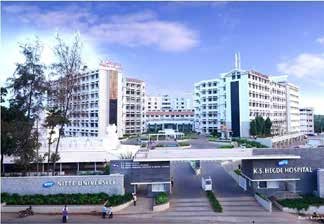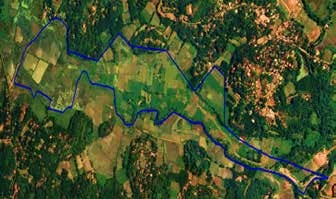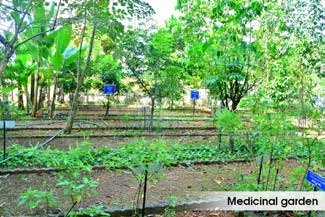
Life on land

Life on land consists of trees, soil, farm, animals, water bodies and human beings widely. Factors like deforestation, poaching, drought, forest fires, soil erosion affect the balance widely. According to United Nations, life on land should aim to protect, restore, and promote sustainable use of terrestrial ecosystems, sustainably manage forests, combat desertification, and reverse degradation and halt biodiversity loss. Prominent organizations like universities play a significant role in facilitating the conservation of resources around us.
NitteDU is committed to the global goal of conservation, restoration of terrestrial and freshwater systems, ending deforestation and restoring degraded forests, protecting biodiversity and natural habitats, preventing invasiveness of alien species on land and water, increasing resources to conserve and use ecosystem and biodiversity sustainably. The university has taken proactive steps by constituting a committee called the Nitte University Green Initiative Project (NUGIP) that oversees and guides all the above-mentioned activities on campus.
NitteDU sustainable campus development project:
Nitte University Green Initiative Project: The committee was constituted and the first meeting was conducted on 30th May, 2017. The chairman of the committee is the Honourable Vice-Chancellor, other members comprised of the Registrar, HOIs, NSS officers, Purchase officer, Estate Manager, Members of faculty from Constituent Institutions in addition to external experts such as Environmental Officers from the pollution control board and environmentalists. The Nitte University Green Initiative Project functions through a committee that forms NSS groups. The members collaborate with faculty and students to tirelessly work for preserving our sustainable ecosystem. Their mode of functioning includes creating awareness through outreach programmes, Vruksha Bhandhan, planting a tree on your birthday, Vanamahotsava, Swachh Bharath, awareness programs, nature camps, organizing field trips: Ayurvana, tree adoption program to name a few.
PLANT A TREE ON BIRTHDAY


Nitte University campus is spread over four sites 150.49 acres. These beautiful campuses house diverse flora and fauna. Out of which the 90 bird species recorded n surveys were submitted to www.ebird.org maintained by The Cornell Lab of Ornithology, 159 Sapsucker Woods Rd. Ithaca, NY 14850. Nitte University campus has approximately 1605 herbal plants, woody shrubs and trees. This has been the result of a continuous ongoing tree planting programme. A tree audit was conducted over six months. GIS tagging of the entire population of trees on campus is attempted. Local trees are having a good representation in the campus.
The campus houses the University administration building, Hospital and Dental College. It has a well-designed garden with several flowering trees, water fountains and lawns. The quaint temple at the entrance also maintains a rose garden which add cheer and colour to the hospital campus. The walkways are covered by a canopy trellis of clock vines (Thunbergia grandiflora) bearing deep purple inflorescence that provide shade and serenity to visitors. The pathways are also provided with stone benches for resting under the floral canopy and enjoy the view of the water fountain. 7.8% of the university area has a green cover with 330 trees and woody shrub.
PANEER CAMPUS:
It is away from the hustle and bustle of traffic. It has the Nitte Gulabi Shetty Memorial Institute of Pharmaceutical Sciences, Nitte University Centre for Science Education and Research, Nitte Institute of Architecture, Nitte Institute of Communication and Nitte Usha Institute of Nursing Sciences. New buildings have sky- lit open space inside the building for availing natural light. A football ground sized playground with a lawn is maintained to support student sports activities of the campus. The campus also has two well-maintained herbal gardens with the rich representation of native medicinal plants. This campus also houses the Girls hostel of the University, a centralized kitchen and a Sewage Treatment Plant (STP). 24% of Paneer campus has a green cover which houses 725 trees and woody shrubs.

KSHEMA CAMPUS AND HOSTELS:
This campus has the K.S. Hegde Medical Academy, Nitte Institute of Physiotherapy, a well-equipped Gym and separate hostels for boys and girls. The Medical Academy building has large inner spaces. These inner quadrangle space provides fresh air and light. It even accommodates quaint indoor gardens which enhances the ambience. A well-maintained foot-ball ground facility is availed by the students of the campus for their everyday recreational as well as sports activities. The avenues are lined with native flowering trees which support the bird and butterfly population of the region. The campus also has a medicinal plants garden with trees and herbs used in plant- based medicines. The green cover extends to 24.3% of the Campus with 939 trees and woody shrubs.KSHEMA CAMPUS AND HOSTELS:
This campus has the K.S. Hegde Medical Academy, Nitte Institute of Physiotherapy, a well-equipped Gym and separate hostels for boys and girls. The Medical Academy building has large inner spaces. These inner quadrangle space provides fresh air and light. It even accommodates quaint indoor gardens which enhances the ambience. A well-maintained foot-ball ground facility is availed by the students of the campus for their everyday recreational as well as sports activities. The avenues are lined with native flowering trees which support the bird and butterfly population of the region. The campus also has a medicinal plants garden with trees and herbs used in plant- based medicines. The green cover extends to 24.3% of the Campus with 939 trees and woody shrubs.
NEW NU CAMPUS:
India has pledged in the Paris Agreement 2015 to reduce emissions by 30-35% below the 2005 emission intensity of GDP by 2030. Hence aligning with the 8 missions identified under National Action Plan for Climate Change, the following fundamental concepts have been considered in the campus master planning process: Microclimate Modifications; Efficient Water Cycle; Clean Energy; Ecological and Biodiversity Enhancement.All the above-mentioned strategies are planned to work within a fabric of dedicated ecological niches, namely the bio-conservation island, forest corridors, riparian edges and deeper water ecosystem. These niches aim to protect, enhance and develop a rich and self-sustaining ecosystem that plays a small scale but very crucial role in regional and global carbon sequestration.

NITTEDU GREEN AUDIT:
The Nitte University campus was assessed for the biodiversity of birds, trees, amphibians and butterflies and the findings are as follows.93 species of birds were spotted and recorded on surveys conducted in 2020. A book of birds was published in 2020 that carries the QR codes for audio sounds of the birds.
Butterflies are indicators of balanced habitat. The presence of plants and shrubs has encouraged a good butterfly population on campus. These plants not only play a role in their diet but also are responsible for the completion of the life cycle of many of the detected species of butterflies. Nine were well documented.
Nitte DU campus is home to 9 species of frogs: They are found in moist, vegetation rich, undistributed regions of the campus. More detailed study is needed to identify and screen the amphibian population of the campus.
Nitte DU campus has approximately 1932 herbal plants, woody shrubs and trees. This has been the result of a continuous ongoing tree planting programme. A tree audit was conducted over a six months’ period. GIS tagging of the entire population of trees on campus is attempted. Local trees are having a good representation in the campus. The plantation drive ensures that flowering trees are planted along the roads and avenues, while fruit trees are planted along the boundary and behind the buildings. Some common trees growing in the campus and a few rare trees are as follows:
Herbal gardens on campus

RESEARCH PUBLICATIONS:
Prabhu SG, Srinikethan G, Hegde S. Spontaneous Cr (VI) and Cd (II) biosorption potential of native pinnae tissue of Pteris vittata L., a tropical invasive pteridophyte. International journal of phytoremediation. 2019 Mar 21;21(4):380-90.Smitha H, Shashikiran N, D’Souza L. Anacardium occidentale cashew. Biotechnology of fruit and nut crops. 2020(Ed. 2):19-26.
Prabhu SG, Srinikethan G, Hegde S. Pelletization of pristine Pteris vittata L. pinnae powder and its application as a biosorbent of Cd (II) and Cr (VI). SN Applied Sciences. 2020 Jan;2(1):1-9.


.png)